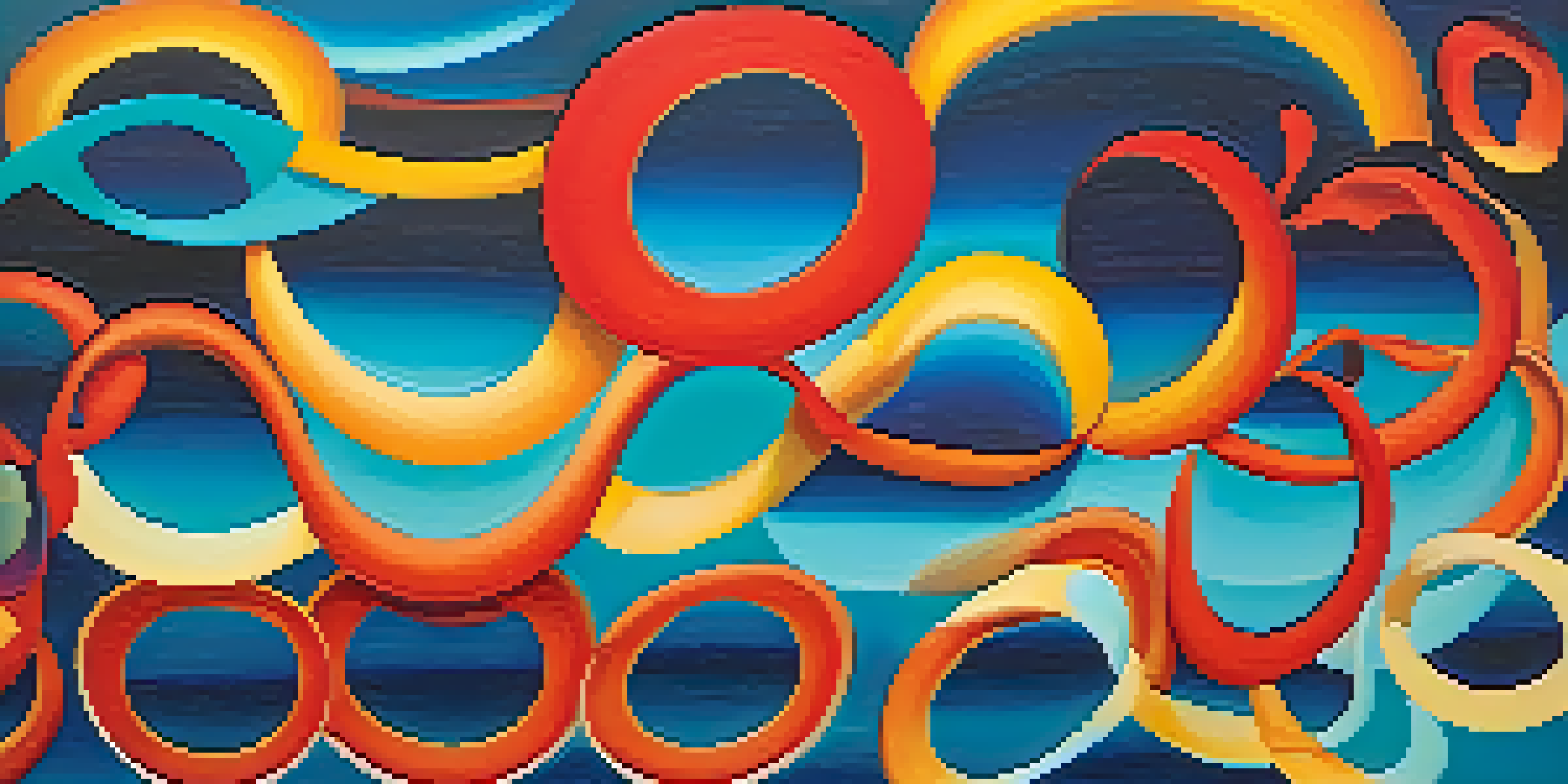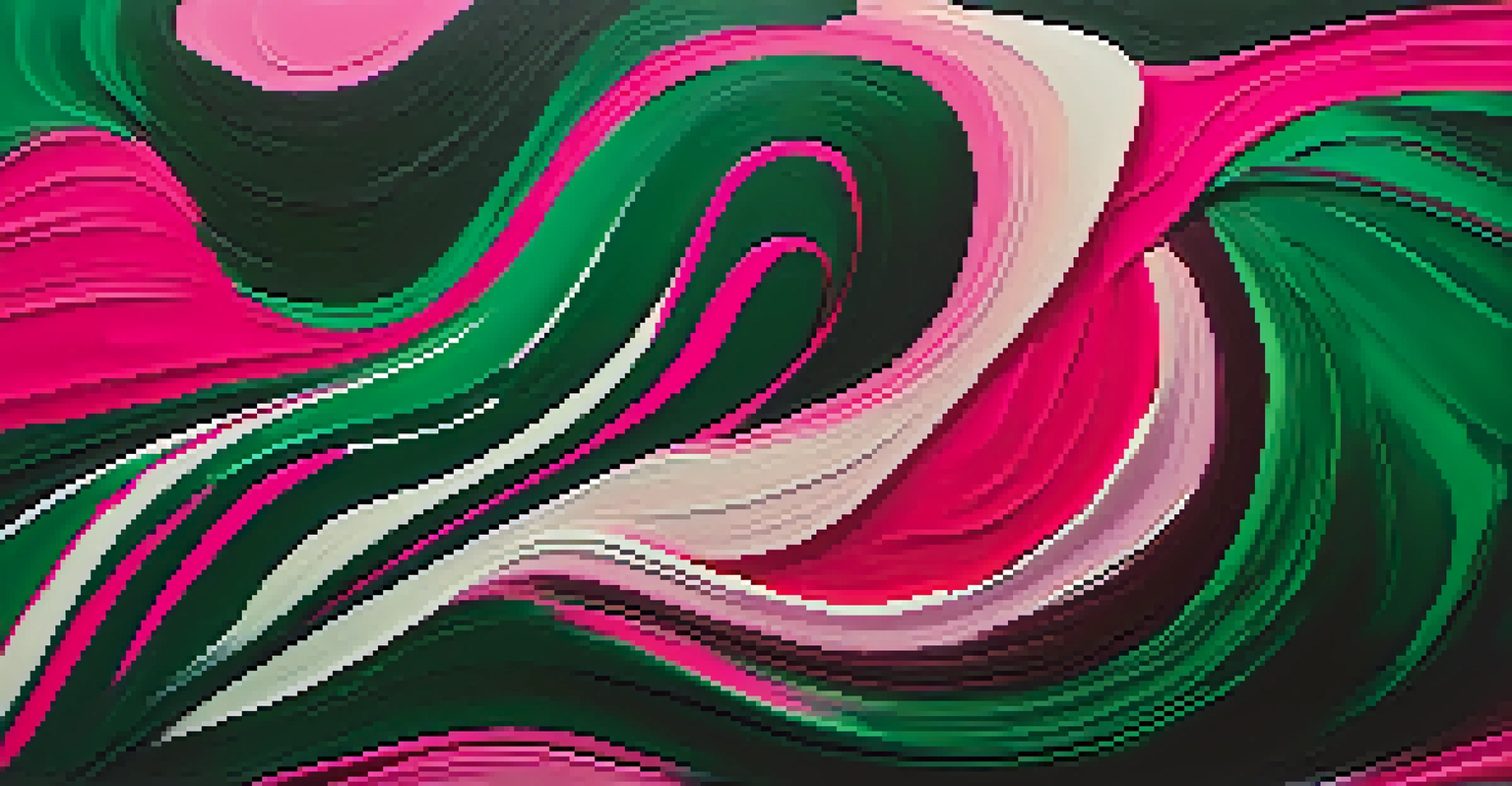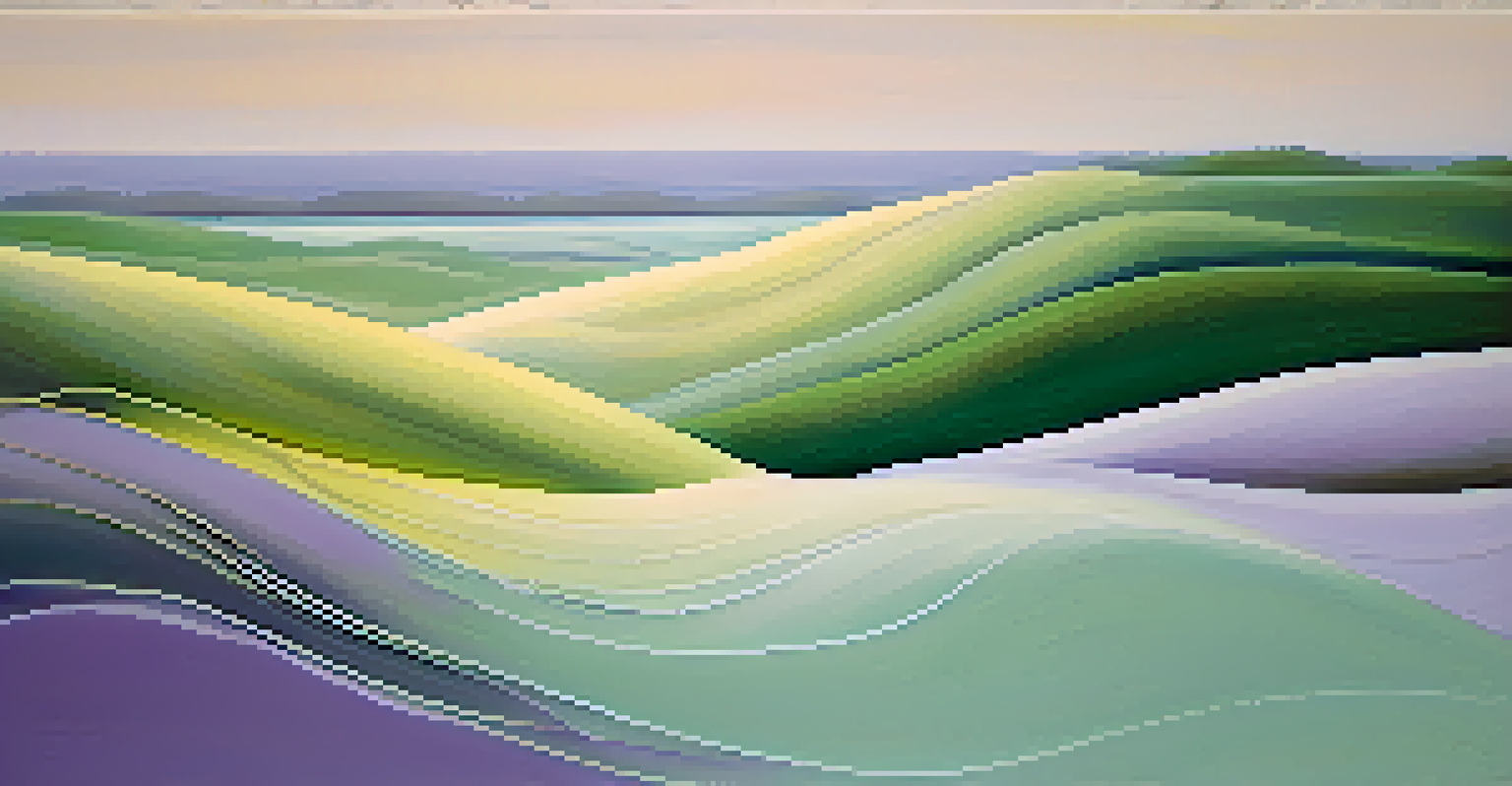The Role of Rhythm in Shaping Abstract Painting Styles

Understanding Rhythm in Art and Life
Rhythm is often associated with music, but it plays a crucial role in visual arts as well. In painting, it can be understood as a sense of movement created through patterns, colors, and forms. Just like a musical piece has beats and pauses, an abstract painting has its own visual tempo that guides the viewer's eye. This rhythmic quality helps to evoke emotions and can create a visceral experience for the observer.
Art is the most beautiful of all lies; it is a rhythm of reality that resonates with our emotions.
Consider how a series of repeating shapes or colors can create a flow in a painting, much like a melody that sticks with you. This can lead to a sense of harmony or tension, depending on how the elements are arranged. Furthermore, the rhythm can vary throughout the artwork, drawing the viewer's attention to different areas, much like the dynamics of a musical composition.
Ultimately, understanding rhythm in the context of abstract painting allows artists to manipulate visual elements to create a more engaging experience. It encourages a deeper connection between the artwork and the viewer, inviting them to explore the piece and discover new layers of meaning.
The Historical Context of Rhythm in Abstract Art
Throughout art history, rhythm has been an essential component in various movements, especially in abstract art. For instance, artists like Wassily Kandinsky and Piet Mondrian employed rhythm as a way to convey emotion and spirituality in their works. Their use of geometric shapes and vibrant colors created a visual melody that resonated with viewers on a deeper level.

As the 20th century progressed, the incorporation of rhythm in abstract painting evolved. Artists began experimenting with different techniques, such as dripping paint or using bold brushstrokes, to establish a sense of movement and energy. This period marked a significant shift in how rhythm was perceived in the art world, as it became a tool for expression rather than just a compositional element.
Rhythm Enhances Visual Experience
In abstract art, rhythm is created through patterns and forms, guiding the viewer's eye and evoking emotions.
The interplay of rhythm and abstraction continues to inspire contemporary artists, who draw from historical influences while pushing the boundaries of the medium. This ongoing dialogue underscores the relevance of rhythm as both a technique and a concept in abstract painting.
Rhythmic Techniques in Abstract Painting
Artists use various techniques to create rhythm in their abstract works, which can range from repetitive patterns to dynamic brushwork. For example, a painter might use a series of circular forms to guide the viewer's eye around the canvas, creating a sense of flow and continuity. This technique can evoke feelings of calmness or energy, depending on the colors and shapes involved.
The artist's job is to be a witness to his time in history, and rhythm is one of the ways to convey that witness.
Another approach is the use of varying line thickness and direction, which can produce a visual beat that resonates with the viewer. This interplay between thick and thin lines can create a pulsating effect, much like the rising and falling notes in music. By consciously choosing these elements, artists can craft an experience that feels both spontaneous and structured.
Moreover, layering different materials or textures can introduce an additional layer of rhythm. The tactile quality of a painting can invite viewers to engage with the artwork physically, enhancing their overall experience. Each technique contributes to the rhythmic quality of the piece, making it a vital aspect of abstract painting.
Emotional Responses to Rhythmic Elements
The rhythm in abstract paintings often elicits strong emotional responses from viewers. When the visual tempo is established through color and form, it can resonate with personal experiences, triggering memories or feelings. For example, a painting with fast, sharp strokes may evoke excitement, while smooth, flowing lines might bring about a sense of peace.
This emotional connection is rooted in how rhythm interacts with human perception. Just as music can uplift or soothe, the rhythm in art can guide our feelings and thoughts. Artists often harness this power to convey specific moods or narratives, allowing their work to communicate in ways that words cannot.
Cultural Influences Shape Rhythm
Different cultures contribute unique rhythmic styles in abstract painting, enriching the artistic landscape with diverse expressions.
Ultimately, the emotional impact of rhythm in abstract painting is what makes it a powerful medium. It invites viewers to not just look but to feel, creating a shared experience that transcends the visual and enters the realm of the emotional.
The Role of Movement in Abstract Art
Movement is a fundamental aspect of rhythm, and it plays a crucial role in the creation of abstract art. Artists often aim to portray a sense of motion, whether through the application of paint or the arrangement of shapes. This dynamic quality can make a static canvas feel alive, drawing the viewer into the artwork's rhythm.
For instance, action painting, an approach popularized by artists like Jackson Pollock, emphasizes the physical act of painting itself. The spontaneous gestures and drips create a visual rhythm that captures the energy of the moment, inviting viewers to experience the chaos and beauty of movement. This technique demonstrates how rhythm and movement work hand in hand to create an immersive experience.
Incorporating movement into abstract art encourages viewers to engage actively with the piece, as they are drawn to follow the paths created by the artist. This interaction fosters a deeper connection and understanding of the artwork, highlighting the importance of rhythm in shaping its overall impact.
Cultural Influences on Rhythmic Styles
Cultural backgrounds significantly influence how rhythm is interpreted and expressed in abstract painting. Different cultures have unique artistic traditions that incorporate rhythm in various ways, from indigenous art forms to modern interpretations. These influences shape the styles and techniques artists use, creating a rich tapestry of rhythmic expression across the globe.
For example, African art often features repetitive patterns and bold colors, which create a rhythmic quality that reflects the community's connection to music and dance. Similarly, Japanese ink painting, with its flowing lines and serene compositions, embodies a different kind of rhythm—one that emphasizes tranquility and balance. Each cultural context adds depth to the understanding of rhythm in abstract art.
Future of Rhythm in Art Evolves
As technology advances, the interpretation of rhythm in abstract painting continues to evolve, leading to innovative artistic practices.
As artists engage with these diverse influences, they blend techniques and styles, resulting in innovative approaches to rhythm in their work. This cross-pollination of ideas enriches the abstract painting landscape, fostering a global dialogue that celebrates the power of rhythm in art.
The Future of Rhythm in Abstract Painting
As we look to the future, the role of rhythm in abstract painting continues to evolve with technological advancements and changing cultural landscapes. Artists are increasingly incorporating digital tools to experiment with rhythm in new ways, pushing the boundaries of traditional painting techniques. This innovation opens up exciting possibilities for how rhythm can be perceived and experienced in abstract art.
Additionally, as global communication becomes more interconnected, artists are likely to draw inspiration from a wider array of cultural influences. This blend of styles can lead to fresh interpretations of rhythm, resulting in a dynamic and diverse art scene. The future of abstract painting promises to be a rich exploration of rhythmic expression.

Ultimately, the ongoing evolution of rhythm in abstract painting reflects the ever-changing nature of art itself. As artists continue to experiment and innovate, the rhythmic qualities of their work will remain a vital component, shaping the way audiences engage with and understand abstract art.